In this post, we will show you how to find out the file system of a drive on a Windows 11/10 PC. There are various file system types with distinct characteristics and features. While some file systems support larger file sizes, encryption, and compression, others are optimized for speed, and compatibility with different devices and platforms.

Knowing which file system a drive is using aids in storage optimization, backup planning, and data protection decisions. In this post, we will see how to find out the file system a drive is using on a Windows 11/10 PC.
What is Drive File system?
A file system refers to the structure that defines how data is stored, organized, and retrieved on a storage device such as hard drives, optical drives, and solid-state drives. It provides a mechanism for the operating system to manage files and directories on a device. Some common file systems used by Windows 11/10 (for drive volumes or partitions on a disk) include NTFS (New Technology File System), FAT32 (File Allocation Table 32), and exFAT (Extended File Allocation Table).
How to find out File System of Drive in Windows 11/10
You can find out the file systems of a drive on your Windows 11/10 PC using these methods:
- Use Disk Management
- Use File Explorer
- Use Settings
- Use System Information
- Use Command Prompt
- Use PowerShell
Let us see this in detail.
1] Use Disk Management
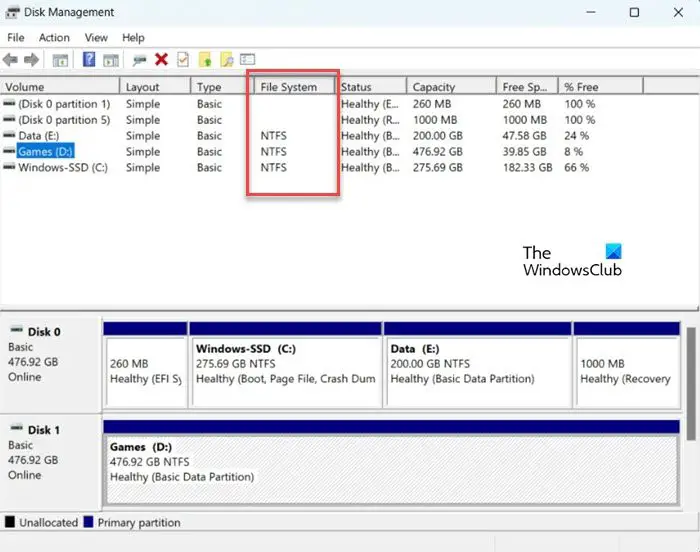
Disk Management is a built-in tool in Windows that shows the file systems of all the drive volumes/partitions on your system at the same time. Using Disk Management is probably the easiest and the quickest way to know the file system a drive is using in Windows.
Right-click on the Start button icon in your taskbar to open the Power User menu (you can also press the Win+X hotkey). Select Disk Management.
The Disk Management tool will appear on your screen. The file systems for all the drives/disk partitions will be listed in the middle of the window under the File System column.
2] Use File Explorer
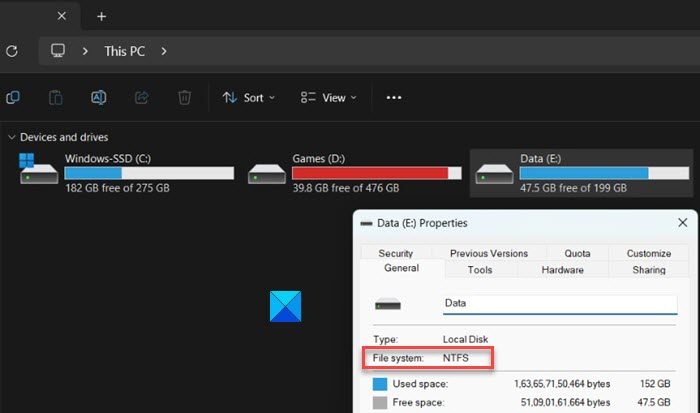
You may use File Explorer to know the file system of individual drives on your system. Click on the Folder icon on your taskbar to open the File Explorer window. Click on This PC in the left panel.
You will see your drives or partitions under the Devices and drives section in the right panel. Right-click on the drive for which you want to check the file system and select ‘Properties’ from the menu that appears. You will see the drive’s file system next to the File system field under the General tab.
3] Use Settings
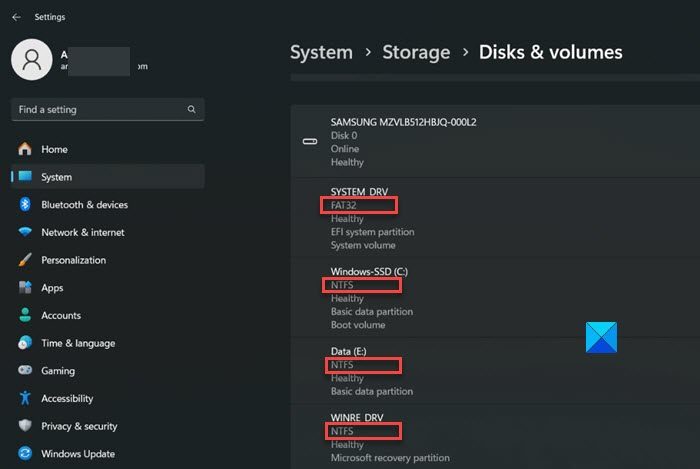
Windows Settings also holds important information about your system’s disks and drives. Click on the Start button icon and select Settings. Click on System in the left panel of the Settings window. Then click on Storage in the right panel. Navigate to the Advanced storage settings section and click on it. The section will expand.
Click on Disks & volumes. You will see the file system for each drive partition/volume on your Windows PC.
4] Use System Information
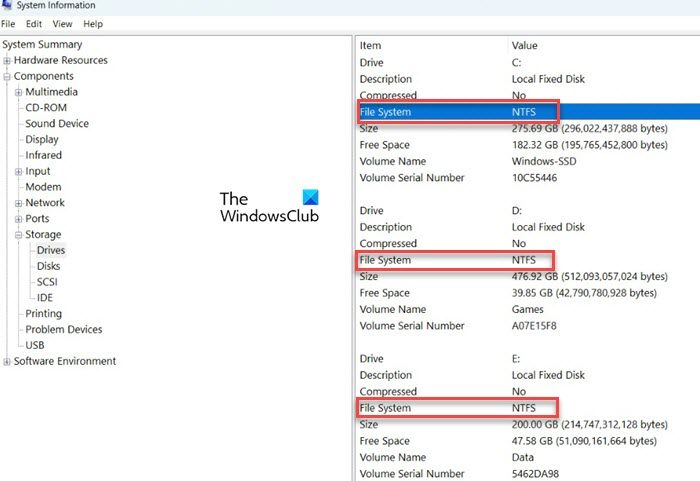
System Information is another utility that can provide detailed information about the hardware and software components of your system. To open the System Information tool, press Win+R and type msinfo32 in the Run dialogue box. Press Enter to execute the command.
In the System Information window, navigate to Components > Storage > Drives (for standard info) or Disks (for detailed info) in the left panel. You will see the file systems for all the drive volumes/partitions on your system in the right panel.
These were GUI-based options to find out which file system a drive is using. If you’re more comfortable with command-line tools, proceed to the next two options.
5] Use Command Prompt
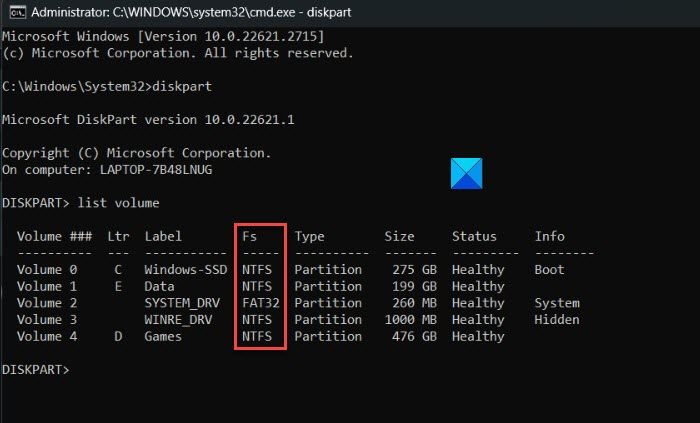
Press Win+R and type cmd in the Run dialogue box. Press Shift+Ctrl+Enter to open an elevated Command Prompt. A User Account Control (UAC) prompt will appear. Click on Yes to continue.
In the Command Promot window, type the following command and press Enter:
diskpart
The above command will invoke DiskPart – a command-line disk partitioning utility for Windows. Now type the following command and press Enter again:
list volume
The above command provides information about drive partitions/volumes on your system. Look under the Fs column to find the file systems of the drives.
6] Use PowerShell
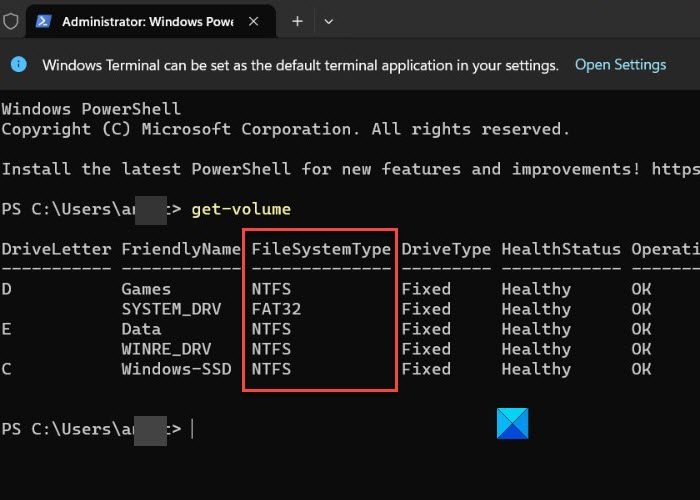
Right-click on the Start button icon and select Terminal (Admin) from the WinX menu. Select Yes in the UAC prompt that appears. This will launch PowerShell with admin privileges.
In the PowerShell window, execute the following command:
get-volume
The above command will list the file system types for each drive partition/volume on your system, along with other information such as drive type, size, etc.
That’s all about it! I hope you find this useful.
Read: Encrypting File System (EFS) on Windows explained.
How do I know if my computer is GPT or MBR?
To determine whether your computer is using GPT (GUID Partition Table) or MBR (Master Boot Record) partition, open Command Prompt using administrator privileges and execute the diskpart command, followed by the list disk command. These commands will provide information about the available disks on the system. Look for an asterisk (*) under the ‘GPT’ column for GPT disks.
Read Next: How to prevent or allow App access to File System in Windows.
Leave a Reply